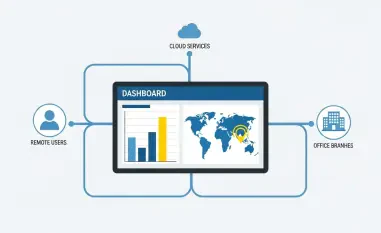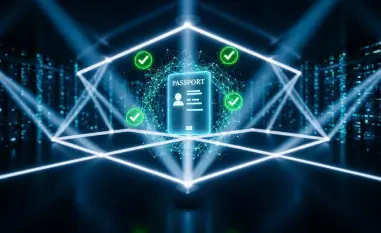Organizational security is often jeopardized by poor identity and access management (IAM) practices. Despite advances in technology and cybersecurity, many businesses still struggle with effectively managing who has access to their systems and data. The article explores various prevalent risks related to IAM and offers suggestions for mitigating these risks. Delving into these key points provides a detailed analysis of how organizations can improve their IAM strategies, enhancing their security posture against potential threats.
Inadequate Role-Based Access Control Policies
One of the first critical issues highlighted is the inadequacy of role-based access control (RBAC) policies within numerous organizations. Poorly defined roles can pose significant security risks, as users may receive inappropriate access, leading to excessive permissions. This problem is often exacerbated by complex organizational structures and role inflation, especially in cloud environments where nonhuman roles like automated processes and service accounts are prevalent. The challenge in creating and maintaining an effective RBAC model is considerable, but addressing it is crucial for maintaining proper security.
Improving this situation involves regularly reviewing and refining roles to ensure they align correctly with actual job responsibilities. Simplifying role hierarchies by consolidating overlapping roles and implementing attribute-based access control (ABAC) where feasible can further fine-tune access rights. ABAC can dynamically control access based on user attributes, environmental conditions, and resource-type attributes, providing a more flexible and scalable approach. Additionally, tools like cloud infrastructure entitlements management (CIEM) can help map out access permissions and identify potential attack paths, making it easier to spot and correct excessive or inappropriate access.
Failure to Deprovision Access Promptly
Many organizations face significant security risks due to the failure to deprovision access promptly when employees change roles or leave the organization. Active accounts that are not promptly deprovisioned can be exploited by both insiders and external attackers, creating a significant vulnerability. This risk is further heightened in cloud environments, where nonhuman identities such as applications and services require managed access as well. The core challenge often arises from inconsistent communication between HR and IT departments, coupled with a lack of automated processes to manage access rights efficiently.
Decentralized systems, where different departments and regions may have their own processes, further complicate the timely deprovisioning of access. Integrating IAM systems with HR platforms to automate the deprovisioning process is essential for mitigating these risks. Automating these processes ensures that changes in employment status trigger immediate changes in access rights. Additionally, conducting periodic audits to identify orphaned accounts and unchecked RBAC roles can reinforce proper account cleanup procedures, further reducing the chances of unauthorized access.
Lack of Multifactor Authentication Enforcement
Relying solely on passwords to secure user accounts leaves organizations vulnerable to a variety of attacks, making the enforcement of multifactor authentication (MFA) crucial. Despite its importance, many organizations do not consistently enforce MFA, leaving accounts susceptible to takeovers through methods like phishing, keylogging, and brute force attacks. Common deterrents to MFA implementation include a lack of visibility into account policies, perceived inconvenience for users, cost concerns, and a general lack of employee buy-in.
To effectively mitigate these risks, implementing mandatory MFA across all critical systems is necessary. This step should be complemented by user education about the significance of MFA and how it works to protect their accounts. Utilizing adaptive or risk-based MFA, which requires additional authentication for high-risk activities such as accessing sensitive data or performing financial transactions, can balance security needs with user convenience. Furthermore, ensuring that the MFA implementation supports various authentication methods like biometrics, token-based systems, and mobile push notifications can increase user compliance and satisfaction.
Lack of Regular Access Reviews, Certifications, and Accreditations
When access rights are not regularly reviewed, issues like excessive privileges and outdated permissions become persistent, significantly increasing the risk of misuse or attacks. Regular access reviews, certifications, and accreditations help ensure that only authorized personnel have access to necessary resources. However, these practices are often time-consuming and difficult to manage, particularly in larger organizations lacking the necessary tools and processes for efficient permissions discovery, reporting, and monitoring.
Automating the discovery of accounts and permissions, as well as the access review and certification processes, can greatly enhance security and efficiency. IAM tools with built-in reporting features can streamline the review process and ensure clear audit trails, facilitating better governance and compliance. These tools can help organizations identify and revoke unnecessary permissions, thus mitigating potential security vulnerabilities. Additionally, creating a culture of accountability and regular audit schedules can further ensure that access rights are checked consistently and accurately.
Poor Identity Lifecycle Management
Inconsistent or delayed management of user identities throughout their lifecycle can create significant security gaps, especially with new IAM scenarios involving cloud, IoT, and other nonhuman identities. Organizations often struggle to manage user identities consistently across various systems and platforms due to the lack of standardized onboarding and offboarding processes. This inconsistency can lead to outdated permissions, orphaned accounts, and other security risks that are challenging to track and mitigate.
Developing a standardized identity lifecycle policy is crucial for mitigating these risks. Such a policy ensures that user identities are consistently managed from the time an employee is hired until they leave the organization. Utilizing identity governance tools can support this process by providing automated workflows to manage access requests, approvals, and revocations. These tools can also help ensure that identity and access policies are consistently applied across all users and systems, reducing the potential for security gaps and enhancing overall compliance.
Weak Password Policies and Credential Management
Weak or reused passwords and inadequate credential management present another common IAM risk. Attackers can exploit these vulnerabilities through credential harvesting, where they obtain passwords using methods like phishing or malware, and credential stuffing, where they use stolen credentials to gain unauthorized access. Outdated password policies, such as requiring overly complex passwords that users cannot easily remember, often exacerbate the issue, leading users to reuse passwords across multiple accounts.
Organizations need to implement strong password policies that encourage the use of unique, complex passwords without being overly burdensome for users. Encouraging the use of password managers can help users generate and store unique passwords securely. Additionally, employing secure password vaults to manage privileged accounts is essential for protecting these highly sensitive access points. Implementing these strategies together can significantly reduce password-related risks, making it harder for attackers to gain unauthorized access to critical systems and data.
Ineffective Privileged Access Management
Uncontrolled privileged accounts are particularly susceptible to misuse, posing a significant risk of insider threats or external breaches. Many organizations fail to adequately monitor and restrict privileged access, often neglecting to log and review privileged activities. This lack of oversight can lead to significant security incidents that can have severe consequences, including data breaches, financial losses, and damage to the organization’s reputation.
Implementing privileged access management (PAM) tools can offer fine-grained control and monitoring of these accounts. These tools enable organizations to enforce strict access controls, log and monitor privileged activities, and detect and respond to suspicious behavior in real-time. Enforcing practices such as just-in-time access—granting privileged access only for specific timeframes and activities—can further minimize the risk window for misuse. Regularly reviewing and updating PAM policies and practices is essential for maintaining robust security and protecting critical assets.
Limited User Awareness and Training on IAM Best Practices
User error due to a lack of awareness about security practices significantly increases the risk of attacks. Often, IAM-specific security training is deprioritized or inadequate, with insufficient focus on zero-trust tools, passwordless options, and phishing-resistant MFA. When employees are not adequately trained on IAM best practices, they are more likely to fall victim to phishing attacks, use weak passwords, or mishandle sensitive information, increasing the organization’s risk exposure.
To address this, periodic training tailored to user roles and emphasizing the impact of secure practices on overall security is necessary. Engaging training methods, such as simulated phishing exercises and practical, scenario-based training, can reinforce IAM best practices and help users understand their role in maintaining security. Additionally, providing ongoing education and support can keep security top of mind for employees, ensuring that they are aware of the latest threats and best practices for mitigating them.
Poor Integration of IAM Across Multiple Systems and Clouds
A common IAM risk arises from the lack of integration of IAM tools across all applications and platforms, creating gaps in visibility, inconsistent access control, and higher administrative overhead. This issue is particularly critical with the rise of federation and cloud-based services, where disparate systems must work together seamlessly. The problem often stems from a mix of legacy, on-premises, and cloud systems that struggle to achieve consistent IAM integration.
Standardizing IAM products across environments and using identity-as-a-service (IDaaS) tools can help unify access management for both cloud and on-premises applications. IDaaS solutions provide a centralized platform for managing identities, streamlining access management, and ensuring consistent security policies across all systems. Implementing single sign-on (SSO) can also centralize user authentication, simplifying access for users while enhancing security. These measures can reduce administrative complexity, improve visibility into access control, and ensure that all systems are protected by robust IAM policies.
Insufficient Logging, Monitoring, and Incident Response for IAM Activities
Organizations frequently overlook the importance of logging and monitoring IAM activities, resulting in missed signs of unauthorized access or attacks. This neglect often stems from budget constraints, inadequate security information and event management (SIEM) systems, or a shortage of trained personnel. Without comprehensive logging and monitoring, it can be challenging to detect and respond to security incidents promptly, leaving the organization vulnerable to significant damage.
Implementing comprehensive logging for critical IAM activities and integrating IAM with SIEM systems for both on-premises and cloud environments can support centralized monitoring. Configuring alerts to notify the security team of suspicious activity and regularly reviewing IAM logs as part of an ongoing incident response strategy are crucial steps. Establishing clear incident response procedures and ensuring that the security team is adequately trained can further enhance the organization’s ability to detect, respond to, and recover from security incidents effectively.
Conclusion
Organizational security often faces challenges due to inadequate identity and access management (IAM) practices. Even with advancements in technology and cybersecurity, many companies find it difficult to effectively handle who can access their systems and data. The article delves into numerous common risks associated with IAM and provides insights on how to reduce these risks.
An analysis of these crucial points can help organizations enhance their IAM strategies and improve their overall security stance. Implementing effective IAM involves ensuring that only authorized users are granted access to sensitive data and systems, thus minimizing the risk of breaches. Organizations must regularly review permissions, implement multi-factor authentication, and conduct rigorous employee training to educate staff on the importance of robust IAM practices.
Furthermore, businesses should invest in reliable IAM software that can streamline the process of managing user access and monitor for any unauthorized activities. Properly configured IAM systems not only protect against internal and external threats but also help in complying with industry regulations. By focusing on improving IAM, organizations can significantly enhance their resilience against potential cybersecurity threats, safeguarding their valuable data and ensuring business continuity.













